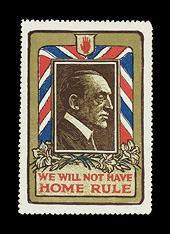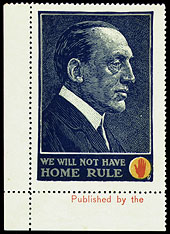ND Home > ND Libraries > Spec. Coll. > Collections > Wolf Irish Stamps > Part I > Set 7L

|
ND Home > ND Libraries > Spec. Coll. > Collections > Wolf Irish Stamps > Part I > Set 7L |
 |
 |
 |
||
L22 Sir Edward Carson (Small Head) [MID] [LAR] |
L24 Sir Edward Carson (Large Head) [MID] [LAR (det)] |
||
Designs: L22 - Sir Edward Carson, framed by Union Jack, with arms of the province of Ulster. Inscription "WE WILL NOT HAVE HOME RULE". 41 x 61 mm. L24 - Sir Edward Carson, with red hand of Ulster. Inscription "WE WILL NOT HAVE HOME RULE". 40 x 60 mm.
Printing: Lithography. The stamps were printed in sheets of ten subjects (5 x 2). Four colors were used for both L22 (brown, gold, red, blue) and L24 (blue, gray, red, yellow).
Separation: Perf 11.
Watermark: None.
Date of Issue: c 1912-14.
Numbers Issued: Unknown.
Notes: The "Home Rule" movement of the late nineteenth and early twentieth centuries sought to bring Ireland a measure of
political autonomy through constitutional means. In 1886, 1893, and again in 1912, Home Rule bills went before Parliament in London. On
the third such occasion, the Liberal Asquith government (dependent on Irish nationalist support) sponsored a bill whereby the whole
of Ireland would, with many restrictive conditions, be granted independence (Home Rule). This bill was passed on its third reading by
the House of Commons, in May 1914. But it was never implemented, due to the outbreak of war later that summer.
Politically, the most significant weakness of the various Home Rule
schemes was their failure to address the specific interests of Protestant northeast Ulster, and it was from this quarter that
the most strenuous opposition to Home Rule came in 1912. These "Ulster Unionists" were led by Sir Edward Carson (1854-1935), a
Dublin-born lawyer who in 1910 became head of the Irish Unionist bloc in the House of Commons. Carson was convinced that only
drastic measures could prevent Home Rule; he did his best to obstruct the bill in the Commons, and with James Craig raised an 80,000 man
force called the Ulster Volunteers to resist the measure forcibly if and when it was enacted. This militancy brought Ireland to the verge
of civil war in July 1914, before the newly passed bill was suspended.
L22 and L24 are examples of a type of cinderella especially common in the years just prior to World War I: the poster
stamp. Like full-sized posters, poster stamps were advertising or propaganda vehicles, used to publicize products, events, or
(as is the case here) political issues. They frequently reached the public by being affixed to letters, invoices, and other
documents and literature of the sponsoring agency. But their obvious visual appeal - they are typically large and multicolored,
and (like posters) tend to exploit contemporary graphic idioms - made them extremely popular as
collectibles; early in the century poster stamp societies and exhibitions were commonplace, and this doubtless became an
independent rationale for their creation. Little is known about the printing of most poster stamps, and these "Anti-Home Rule"
labels (commonly known as the Carson small and large heads) are no exception. The portrait type of Carson also appears in a 1914
etching by John George Day (National Portrait Gallery, London; NPG 2916); whether the Day etching was in fact the specific model
for the poster stamps is not certain. These particular labels have received very little attention in the philatelic literature.
Provenance: Dr. Charles Wolf.
Bibliography: MacDonnell and Whyte, 1991, 13
[Next Set] [Previous Set] [Return to Table of Contents]
|
|
|||||||||||||||||||
|
|||||||||||||||||||